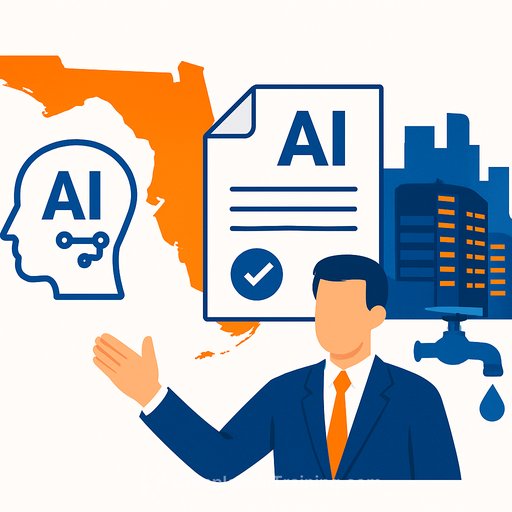AI adoption surges in re/insurance, but governance still trails
AI has moved from pilot to standard in re/insurance, especially in claims. A new Sollers Consulting study of 35 carriers and reinsurers across Europe and North America shows strong momentum in operations, with uneven readiness to scale.
The biggest near-term impact: claims processing, back-office efficiency, and customer experience. Leaders expect the next three to five years to bring more AI into underwriting, prevention, and sales.
Where AI is working right now
- Claims: 64% use AI in motor re/insurance for tasks like document deduplication and email triage.
- Data extraction: 69% are using or introducing AI to pull data from documents and systems.
- Chatbots: 60% adoption, mostly for front-line Q&A and policy support.
- Call centers: Still early, with 38% acceptance for AI support tools.
LLMs are now common across many firms, with some rolling out general AI tools for employees to test. The upside is speed; the risk is sprawl without clear standards.
What this means for policyholders
Faster claims and underwriting decisions. Clearer communication on risk. Pricing that reflects individual profiles and behavior. That's the promise most teams are building toward.
Follow the money
Gallagher Re reports 2024 insurtech funding at US$4.25B, down 5.6% year over year. Even so, AI-focused startups drew more attention-Q4 saw AI deals make up 42.3% of all transactions, with half tied to claims technology.
Signals are clear: capital is flowing to tools that remove friction and shorten cycle times.
The governance gap
Despite adoption, 26% of surveyed companies have no formal AI governance. That invites model drift, duplicative projects, and compliance issues. The firms that set clear guardrails and shared services will move faster with less noise.
Practical playbook for carriers and reinsurers
- Set ownership: Create an AI steering group across claims, underwriting, actuarial, legal, IT, data, and risk. Define approval paths and model standards.
- Prioritize use cases: Rank by value, feasibility, and data readiness. Start with claims intake, document processing, and subrogation triage.
- Data first: Standardize document pipelines, OCR quality, and entity mapping. Decide on retention, lineage, and audit trails upfront.
- Safe LLM access: Provide a sanctioned workspace with logging, redaction, and PII controls. Block shadow tools.
- Controls: Bake in model testing, bias checks, and monitoring. Keep humans-in-the-loop where decisions affect coverage or settlement.
- Pilot to scale: Prove ROI in one line of business, then templatize. Reuse components to avoid one-off builds.
- Measure what matters: Cycle time, leakage, indemnity impact, FNOL-to-decision time, NPS/CSAT, loss-adjustment expense.
- Upskill teams: Train adjusters, underwriters, and brokers on prompts, verification, and exception handling.
- Vendor strategy: Standardize procurement and integration patterns. Require clear APIs, auditability, and model transparency.
- Communicate with customers: Explain how AI supports decisions and how human review works. Reduce surprises.
Quick wins you can ship this quarter
- Claims intake: Email triage and document routing with confidence thresholds.
- Document automation: Deduplication, OCR, and data extraction into core systems.
- Adjuster assist: Summarize claim notes, generate next-best actions, and prefill correspondence.
- Subrogation/fraud triage: Score and route cases for deeper review.
- Underwriting intake: Pull key fields from submissions and broker emails; flag missing data.
- Broker/agent chatbot: Answer product and process questions; log unresolved items for human follow-up.
- Agent assist in call centers: Start with a narrow POC on common intents to prove value.
Risk and compliance, handled
Treat AI like any other decision system. Document models, datasets, and controls. Keep audit logs. Involve legal and compliance early. Above all, keep people accountable for final decisions that affect coverage and payment.
Need to upskill your team?
If you're building internal capability across claims, underwriting, or operations, structured training shortens the learning curve. Explore role-based programs and certifications:
Bottom line
AI is already delivering in claims and data processing. The constraint isn't technology-it's governance, data quality, and change management. Get those right, and the next three years will pay off in underwriting, pricing, and customer experience.
Your membership also unlocks:






